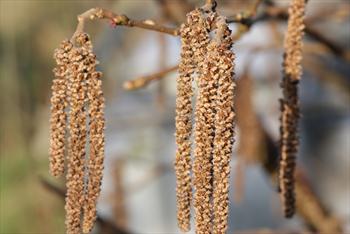
All hazel and cobnut varieties are effectively self-sterile so you should always plant at least two different varieties. The following table shows which varieties will pollinate.
Start in the first column and find the variety you wish to plant. Then note the varieties in the subsequent columns which will pollinate it. Pollination is not necessarily 2-way, so repeat the process for each variety you intend to plant.
Hazels and cobnuts are wind-pollinated and the pollinator should ideally be no more than 50m away, although pollination can be effective over much longer distances particularly if the pollinator is upwind in the direction of the prevailing wind.
Most hazels and cobnuts we supply will also be pollinated by wild hazels which you may already have in your area. Wild hazels produce large quantities of highly-compatible pollen over long periods and distances.
Table of hazelnut / cobnut pollination
| Variety providing the pollen | |||||||||||
|---|---|---|---|---|---|---|---|---|---|---|---|
| Variety to pollinate | Butler | Corabel | Cosford | Ennis | Gunslebert | Gustav's Zeller | Hall's Giant | Kent Cob | Lange Tidling Zeller | Tonda di Giffoni | Wild hazel |
| Butler | |||||||||||
| Corabel | |||||||||||
| Cosford | |||||||||||
| Ennis | |||||||||||
| Gunslebert | |||||||||||
| Gustav's Zeller | |||||||||||
| Hall's Giant | |||||||||||
| Kent Cob | |||||||||||
| Lange Tidling Zeller | |||||||||||
| Tonda di Giffoni | |||||||||||
More details about how to grow hazel and cobnut trees.
